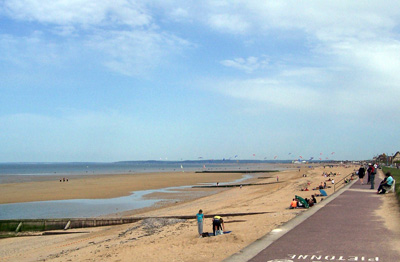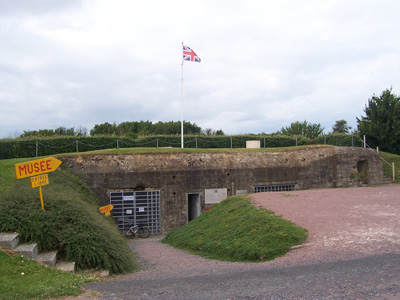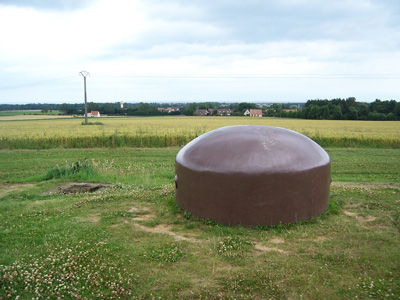
WWII: Maginot Line | Normandy | V-Weapon Sites | Arnhem
Further afield: Crete
| Home Tracing Military Ancestors Travel Advice CWGC Cemeteries Iron Harvest News Book Reviews Glossary Links Contact Me Normandy Landings:
 
|
Location 7 – Strongpoint HillmanView of SWORD Beach – Whilst possessing a number of interesting features from the landings including a coastal observation bunker which now houses the Musée le Mer de l'Atlantique, post-war development at SWORD Beach means that the course of the action here does require a fair amount of interpretation. It will, therefore, be the focus of a future warwalk, which will concentrate specifically on the fighting in this area. Directions – However, the SWORD assault sectors of QUEEN White and Red are passed if you continue westwards on the D514 coast road from St Aubin-sur-Mer and through the coastal towns of Langrune-sur-Mer, Luc-sur-Mer and Lion-sur-Mer following signs to Ouistreham and the car ferry. About a kilometre outside Lion-sur-Mer you will see a Centaur close support tank of the Royal Marines on your left. Turn left here into Rue du Dr. Turgis and park. Walk up Av. Felix Faure to the sea.
To reach Strongpoint Hillman, rejoin the D514 and driving in the direction of Lion-sur-Mer, take the first turning on the left, the D60b to Hermanville-sur-Mer. Continue through the village and, on exiting, turn left onto the D35 to Coleville-Montgomery. When you reach the centre of this village turn right following signs to Biéville. Continue on this road which will begin to rise as you leave the village. At the top, beyond the trees, Strongpoint Hillman will be seen on the right. Park in the car park. IMPORTANT NOTE: At the time of writing access to Hillman is limited to Mondays to Saturdays (3pm to 7pm) on 6th June and 1st July to 15th September inclusive although guided tours can be arranged in advance all year round. For details contact suffolk@amis-du-suffolk-rgt.com. Further visiting details and photographs of Hillman can be found at www.amis-du-suffolk-rgt.com.
What Happened on D-Day? – Strongpoint Hillman (code-named after car manufacturers by the British - neighbouring positions were known as "Daimler" and "Morris"), was the strongest German position inland of SWORD Beach and guarded the road to Caen. Begun in 1942, it was the Headquarters of the German 736th Infantry Regiment under Oberst Krug and had a garrison of 150 men. Its anti-tank guns and machine-guns within carefully sited underground bunkers, some with armoured cupolas impervious to tank fire, dominated the slope leading up from SWORD. For the British to make rapid progress into Caen, it had to be taken, and quickly.
On D-Day that task fell to 1st Battalion, The Suffolk Regiment, the reserve battalion of the SWORD assault brigade, the 8th, under Lt-Col R.E. Goodwin DSO. Earlier in the morning the unit had moved through Hermanville before pushing into Coleville where C Company cleared the village. In the meantime, B Company captured Strongpoint Morris, a 105mm-gun battery adjacent to the Périers road leading out of Coleville to the east. Its garrison had been badly demoralised by Allied bombing prior to D-Day and accurate naval fire from the Polish cruiser, Dragon, in the early morning and surrendered as soon as the Suffolks approached. Hillman was a much sterner obstacle. The concrete emplacements were formidable enough, but in addition, they were surrounded by anti-tank and anti-personnel mines and encircled by two belts of barbed wire. Further, due to bad visibility over the target, Allied bombing in the days leading up to the 6th June had been inaccurate and the ability to direct naval gunfire onto the position had been lost when the 1st Suffolks Forward Observation Party (FOB) were wiped out by a mortar bomb whilst leaving their landing craft. However, the Suffolks could rely in the support fire of 7th Field Regiment, Royal Artillery that had now landed, the guns of the Sherman tanks of C Squadron 13th/18th Hussars and their own 3-inch mortar platoon. The first attack on Hillman commenced at 1310 with a short bombardment following which D Company used Bangalore Torpedoes to create a breach in the inner and outer wire on the northern edge of the position, whilst a mine clearance team probed for a gap in the minefield. The activity drew German fire and machine-guns from the armoured cupolas raked the breach as A Company left the cover of the sunken roadway from Coleville, suffering many casualties as they began to clamber into the position. The German defenders in the connecting trenches withdrew into their concrete bunkers leaving the British facing the task of taking each emplacement in turn. By now a huge traffic jam was building up in Coleville and a number of tanks had been lost, some to mines on the road and others to unseen anti-tank guns. Lt-Col Goodwin saw that the only way to silence the position without a bloodbath was to get supporting armour through the wire and minefield right into the heart of Hillman so that infantry sheltering behind the tanks could engage each bunker at close quarters. Ideally, a wider gap through the mines for tanks would have been cleared by Sherman flails but these were some way off on the beach and so the British began to clear a 5-yard gap by hand. This hazardous task, continually under fire from the cupolas, took until mid-afternoon. Corporal Boulton and Lieutenant Arthur Heal were later awarded the Military Medal and Croix de Guerre respectively for their vital work in clearing the way forward. Once the breach was made, a new five-minute bombardment was called, following which the tanks sped through with the infantry on their heels. Inside the perimeter the infantry of the 1st Suffolks spread out. The armoured cupola of Command Post A was at last engaged and put out of action by the Bren gun of Private "Tich" Hunter – an act which earned him the Distinguished Conduct Medal. Actually the German defenders, safe within their subterranean fortresses, held out for some time, although with their firing positions destroyed or overrun they had no means of engaging their assailants – firing effectively having ceased by 2000. At midnight Oberst Krug telephoned his divisional commander, Generalmajor Wilhelm Richter in Caen,
"…the enemy are on top of my bunker. I have no means of resisting them and no communications with my men. What should I do?" Richter could offer his subordinate no further support – his division had effectively ceased to exist as a fighting unit. "I can give you no more orders. You must make your own decision now." Extract from Sword Beach by Tim Kilvert-Jones, 2001 Pen & Sword Books.
The next morning, Krug, his staff and 70 men, ascended from the depths of their Command Post and surrendered. Hillman was captured, but its resistance in the late morning and afternoon of D-Day had ensured that Caen would remain unoccupied by the British. It was not entered until 18th July. For their part in "The Longest Day", on which they had taken all of their objectives, 1st Suffolks and the attached C Squadron, 13th/18th Hussars had suffered eight killed and 32 wounded.
|


